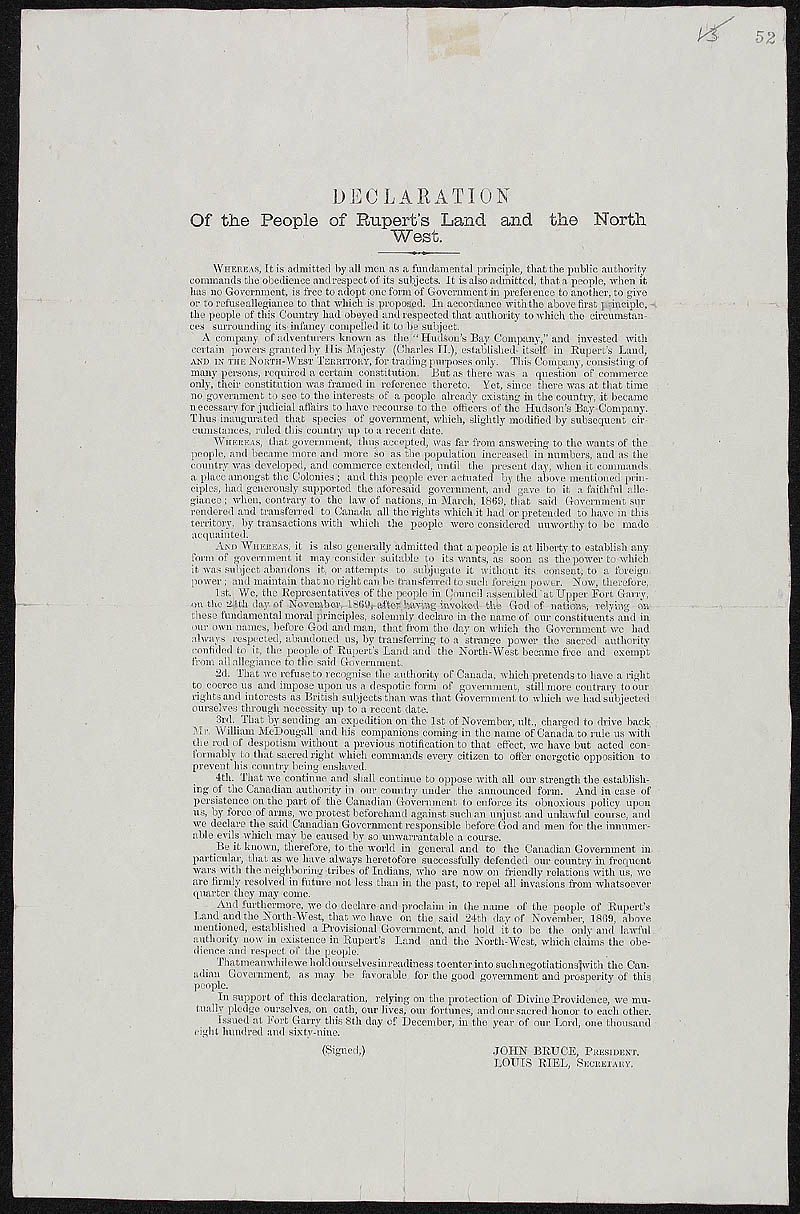For time throughout the 1860s the Metis identity was something that had to be fought for. A man, Louis Riel, and John Bruce constructed a document called “Declaration Of the People of Rupert’s Land and the North West. This document was quite important for identifying and creating an identity for a group of people misplaced in society. This document was written to demand that the people of this area be recognized as Metis, and be a self governing entity within Canada. This analysis will explore the biases of the two authors, as well as what motives were behind the creation, the purpose of the Declaration and lastly the attitudes towards creating this identity for the People of Rupert’s Land and the North West.
this identity for the People of Rupert’s Land and the North West.
This Declaration, created by Louis Riel and John Bruce, was a starting point, and a legal demand for their people to be recognized as sovereign within Canada. It is important to know that Louis Riel in particular was a Metis man whom throughout his life fought for the rights of Metis people. He could certainly be seen as biased because of his own heritage, therefore some of the demands he set forth may be seen as quite aggressive. His fist Declaration is “…strange power the sacred authority confided to it, the people of Rupert’s Land and the North-West became free and exempt from all allegiance to said Government.”1 What is being asked simply is to become free from Canada, and be self-governing, much like his Indigenous contemporaries. Although we need to ask why this was so important. A request like this could be because of years of mistreatment and being Metis itself made these people not fit into being Indigenous and not White either which really misplaces them within society. This causes a feeling of not belonging anywhere in society so it would make perfect sense for Riel and Bruce to demand this from Canada. As alluded to this idea around identity is very important. This was a way for the Metis people of the area to create their own identity and community, much like the Acadian people before them.
The second demand listed was, “we refuse to recognize the authority of Canada…”2 What is mentioned later is how the Canadian Government has abused and coerced. This might be mentioned because of certain mistreatment towards the Metis people and Louis Riel himself. It was during a time of conflict against the Canadian Government and them imposing British rule among the predominant French speaking Metis. This certainly highlights a feeling of disdain towards the government as well and is integral to being granted this self governing identity as they could not be a sovereign nation with the Canadian government still controlling them with their laws and values. It is also important to note that during this time many of the Metis and Indigenous peoples were feeling religious, nationalistic and racial tensions towards them from the English settlers who would have been Protestant versus Catholic leading to mistreatment of many people who do not share the same views. Also by getting away from Canadian rule they may have tried to keep the land they occupied as it was not owned by the Metis people but by the Hudson Bay Company, and when surveyors were sent to survey the land it must have created much anxiety for people. All more reasons to demand to step away from Canadian rule, and stop being oppressed under a white, Protestant nation.
To lead into this fear of anxiety we are faced with the third demand,
That by sending an expedition on the 1st of November, nlt., charged to drive back Mr. William McDougall and his companions coming in the name of Canada to rule us with the rod of despotism without a previous notification to that effect, we have but acted comfortably to that sacred right which commands every citizen to offer energetic opposition to prevent his country being enslaved.3
Much like said before a lot of issues caused by this surveying had to do with the uncertainty of what might happen to the Metis once the Canadian government purchases the land from the Hudson Bay Company. We certainly get the sense that the fear of being enslaved is a strong possibility. With the introduction of residential schools and such the fear that people will be taken away from home would have been a reality. It is interesting that “to prevent his country being enslaved” is used, specifically the word country. This once again plays into this want and need for an identity. These are people that did not quite fit within the idea of Indigenous poeples, nor white people. Riel and Bruce, hopefully with the support of most really wanted to be their own country.
The last demand really ties in all these feelings of the government’s wrongdoings, the need to step away from Canada and establish its own identity. Bruce and Riel certainly lay the foundation for rebellious attitudes which may be their bias towards the government and its treatment. It is stated that, “we protest beforehand against such an unjust and unlawful course…”4 This just further shows that Bruce and Riel will not tolerate such unjust treatment towards them and their people. Whether or not every member felt this way we can not know for sure, but later events do illustrate a unity among many. It was this unity that brought these people together and perhaps gave them a sense of belonging and that is what the goal of this Declaration was. This was something to bind a group of displaced people and give them a sense of worth and identity and while aggressive in nature it fed into certain “nationalistic” feelings and helped to unite a group and get them recognized within Canada.
1John Bruce, Louis Riel, Declaration of the People of Rupert’s Land and the North-West, December 1869.
2Ibid.
3Ibid.
4Ibid.
